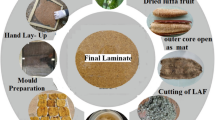Abstract
Short-cut carbon fibers were used to adhesively reinforce the end of a pine (Pinus spp.) wood member. The test specimens were fabricated with an epoxy resin content of 150 or 250 g/m2, fiber content of 120 or 170 g/m2, pressing pressure of 0.10 MPa and pressing time of 24 h. In addition, the dispersion degree of short-cut carbon fibers in adhesive was examined. It was found that the dispersion degree increased with decreasing fiber length. Carbon fibers greatly improved the shear strength of bond layers between wood ends. The tensile strength of short-cut carbon fiber reinforced plastic (CFRP) increased with increasing fiber length. However, there was almost no difference in the tensile strength of CFRP made of 2, 3 and 5 mm long fibers. The tensile strength of a wood member with reinforced end was twice as high as or more than that of unreinforced ones. High shear strength of bond layers between wood ends could be obtained at fibers content of 170 g/m2 and resin content of 250 g/m2. It could be suggested that the reinforcement technology of using short-cut carbon fibers is a feasible way to improve the tensile strength of the end of a wood member.









Similar content being viewed by others
References
Bodig J, Jayne BA (1982) Mechanics of wood and wood composites. US National Agricultural Library, Van Nostrand Reinhold, NY
China National Standard (2002) GB/T 50329-2002. Standard for methods testing of timber structures. China National Standardization Management Committee, China
Gezer H, Aydemir B (2010) The effect of the wrapped carbon fiber reinforced polymer material on fir and pine woods. Mater Des 31:3564–3567
Gu LB, Zhang YC (2011) Timber manufacturing technology. China Forestry Press, Beijing
Jankowski LJ, Jasienko J, Nowak TP (2010) Experimental assessment of CFRP reinforced wooden beams by 4-point bending tests and photoelastic coating technique. Mater Struct 43:141–150
Kim YJ, Harries KA (2010) Modeling of timber beams strengthened with various CFRP composites. Eng Struct 32:3225–3234
Li YF, Xie YM, Tsai MJ (2009) Enhancement of the flexural performance of retrofitted wood beams using CFRP composite sheets. Constr Build Mater 23:411–422
Meier U, Deuring M, Meier H, Schwegler G (1992) Strengthening of structures with CFRP laminates: research and applications in Switzerland. In: Proceedings of the first international conference on advanced composite materials in bridges and structure (ACMBS-1). Sherbrooke, Quebec, Canada, pp 243–251
Nanni A (1993) Fiber-reinforced-plastic reinforcement for concrete structures: properties and applications. Elsevier, Amsterdam
Pi CS, Wu YL (2006) Wood products surface decoration technology. Chemical Industry Press, Beijing
Tingley DA (1996) The Stress-Strain Relationships in Wood and Fiber-Reinforced Plastic Laminate of Reinforced Glued-Laminated Wood Beams. Oregon State University, Corvallis
Yang XJ, Gong M, Chui YH (2014) Short-term creep behavior of CFRP-reinforced wood composites subjected to cyclic loading at different climate conditions. Bioresources 9:1845–1857
Acknowledgments
This work was supported by the National Natural Science Foundation of China (31300484), the Priority Academic Program Development of Jiangsu Higher Education Institutions (PAPD), the research fund of Highest Academic Qualification (GXL201314) and by College Students’ Innovative Undertaking Projects in Jiangsu province (201310298052Z).
Author information
Authors and Affiliations
Corresponding author
Rights and permissions
About this article
Cite this article
Yang, X., Gong, M. & Chui, Y.H. End reinforcement of wood member using short-cut carbon fibers. Eur. J. Wood Prod. 73, 159–165 (2015). https://doi.org/10.1007/s00107-014-0867-8
Received:
Published:
Issue Date:
DOI: https://doi.org/10.1007/s00107-014-0867-8




